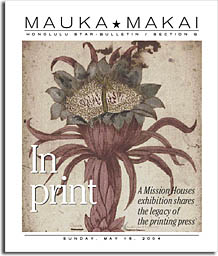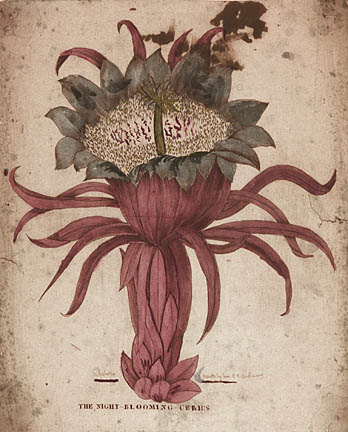
[ MAUKA MAKAI ]
Mission Houses Museum senior interpreter Peter Salter demonstrates 19th century printing on a reproduction of a Ramage Press..
First Impressions
Education dominated early efforts
at island printing and engraving
In 1834, Ka Lama Hawaii, the first newspaper west of the Rockies, was published locally. It was a lot different from the newspaper in front of you today.
Where today we try to raise awareness through coverage of world and business news, and entertain with the feel-good puffery of pop cultural phenomena like "American Idol," the four-page issue of Ka Lama Hawaii had the more basic purpose of education. Really basic. Its front page featured a different animal each day.
These were animals that our Hawaiian ancestors might never have seen before, according to Marilyn Reppun, head librarian and co-curator of the "Lasting Impressions: Printing and Engraving in Hawaii" exhibit at the Mission Houses Museum. The exhibition, continuing through June 26, tells the story of the introduction of print and engraving to Hawaii in the early 19th century, its impact and lasting influence.
"Lasting Impressions: Printing and Engraving in Hawaii"
Where: Mission Houses MuseumHours: 9 a.m. to 4 p.m. Tuesdays to Saturdays
Admission: $6
Call: 531-0481
Also: Take a tour of the museum 10 a.m. to 4 p.m. Saturdays.
"Brain Food!"
» Gallery talks: Held in conjunction with "Lasting Impressions," with lunch hosted by Winterbourne Tea Parlor, noon to 1:15 p.m., $14.» Thursday: Printmaker Jared Wickware discusses works of early Hawaiian printmakers.
» May 27: Malcolm Naea Chun discusses his collaborative efforts to revise the Hawaiian Bible.
» June 10: Children's book author Jim Rumford talks about the design of early children's books.
Among the historical objects in the exhibition are a 19th-century printing press; a rare series of copperplate engravings and prints produced in Lahainaluna, Maui, in the 1830s and '40s; early hymnals; and public notices and announcements from the alii.
The press made it possible to preserve snippets of Hawaiian culture. The last page of Ka Lama Hawaii, for example, was reserved for a feature called "Native Genius," in which native Hawaiians were able to write about their traditions, including historic tales or songs of lament, Reppun said. "Students would be seen on campus reading every issue intently."
Alas, commercial considerations were in effect even then. The paper did not have a wide circulation and lasted only about a year.
Ke Kumu Hawaii (The Hawaiian Teacher) started up with paid subscriptions and remained for five years. Later, the government used the press for lawmaking purposes including proclamations, rules and regulations.
THE MISSIONARIES who introduced the press arrived with the aim of spreading the written word to the Hawaiians. Millions of pages were printed by 1840, Reppun said.
But before they could expect the Hawaiians to read a Bible in Hawaiian, they had the task of teaching these new Christians to read. Some of the earliest pieces off the Mission Press were the first Hawaiian alphabet.
The first printed impression was made on the Honolulu Mission's press in January 1822. Keeaumoku, also known as Gov. Cox of Maui, was given a composing stick and set the first characters of type in the newly introduced written Hawaiian language.
The development of the written Hawaiian language is documented with the first vocabulary words and Lorrin Andrew's first Hawaiian language dictionary containing about 5,700 words. "It is still used by Hawaiian language scholars," Reppun said. "Within a decade, many schools were started, and the demand for books was greater than the Mission Press could meet."
Students attended classes at Lahainaluna Seminary on Maui (currently Lahainaluna High School) to become teachers and preachers. Maps were created and books from geography to math and science, history and philosophy. Before it became mandatory for kids to attend school, most of the students for book learning were adults.
In 1831 a printing house was established at the Lahainaluna Seminary in order to print Bibles, hymnals and teaching materials.
"Lots of credit goes to Lorrin Andrews," Reppun said. "He thought it was important to teach students, but he wanted to provide them with interesting textbooks so that they would want to learn."
Map making was another skill taught at the seminary, she said. Old maps of the Middle East exist, as well as a map of the United States, dating to a time when there were only 26 states in the union.
On the cover: Night-blooming cereus, circa 1840, is a copper engraving drawn by Parnelly P. Andrews and engraved by Kepohoni.
ONE OF THE most significant pieces on display is the Hawaiian-language Bible, hand-stitched with untrimmed pages.
"In 1839 a Bible with both the Old and New testaments was bound up with 2,331 pages," said Peter Salter, senior historic interpreter of the museum. The Bible was finished during a 17-year span. A Wells Press and a Rust, or Washington, Press was needed to complete the project. "The enormous endeavor couldn't have been undertaken singularly with their used Ramage press," Salter explained. Eventually, 10,000 copies of Ka Palapala Hemolele, or the Holy Bible, were printed and distributed, he said.
Using a "faithful reproduction" of the original Ramage Press, Salter presents a printing demonstration at noon on Tuesdays, Thursdays and Saturdays at the museum. Machine shop and carpentry students at Honolulu Community College built the replica in 1966. "Their Ramage Press was secondhand, yet it was entirely useable for their purposes. At the time, it was a state-of-the-art press," he said.
In creating the books, there were often two people involved, with a division of labor between the artist and the engraver. Andrews taught himself the trade of copper engraving. "He would obtain sheet copper from the ship captains," Reppun said. "People are familiar with engraving comment on the fine and beautiful workmanship" involved in early printing.
Many of the engravings are objects of natural history, from depictions of landscapes to fish and the night-blooming cereus. "Kaawaloa Bay," by Persis Thurston, features a view of Kealakekua Bay and marks the spot where Capt. Cook was killed in 1779. Several works by contemporary artists from Honolulu Printmakers are also displayed.
Musical history is another facet of the exhibition. To teach Hawaiians "to harmonize like the westerners," sheet music and hymnbooks were printed.
Exposure to hymns in the 1800s made an impact that resounds today. "Hawaiians started out chanting with precise resonation. Today, the music is more melodic and Hawaiians are prolific songwriters," said Reppun.
Noting the incredible acoustics of Kawaiaha'o Church, she said, "Hundreds of people singing their each week must have provided inspiration."
"The extraordinary works exist as a tribute to the prowess of early printers," Salter added. "Their work remains as an outstanding historic legacy of that era."
Click for online
calendars and events.



